Characteristics
- Arms
- Ridges present along aboral midline of arms I, III and IV but indistinct on arms II in both sexes.
- Arm suckers globular with smooth inner rings.
- Males
- Arm formula: 2.3.1.4.
- Females
- Arm formula: 2.3.4.1.
- Web
- Males
- Web formula: D>A=E>C=B.
- Deepest web (sector D) 27-29% of longest arm; webs A, E 10% of longest arm and webs C,B 5-8% of longest arm.
- Web formula: D>A=E>C=B.
- Females
- Web formula: D>C>B=A>E.
- Deepest web (sector D) 38% of longest arm, web C 26%, web B, A 14% and web E about 7% of longest arm.
- Web formula: D>C>B=A>E.
- Males
- Tentacles
- Protective membranes well developed.
- Tentacular stalk circular in cross-section proximal to club.
- Stalk more slender than arms.
- Club suckers with fine triangular teeth around entire margin of inner ring.
- Protective membranes well developed.
- Head
- Each eye large, with cornea and secondary ventral eyelid.
- Eye pore absent.
- Olfactory organ not found.
- Upper beak
- Rostrum pointed, slightly curved rostrum.
- Lateral wall damaged, presence of depression unknown.
- Jaw angle nearly 90°. Cutting edge of shoulder irregular.
- Crest wide, slightly curved.
- Entire beak, except the margin, brown;rostrum and upper part of shoulder black; margin clear.
- Rostrum pointed, slightly curved rostrum.
- Lower beak
- Rostrum with slightly curved, irregular, sharp, thick edge.
- Acute jaw angle.
- Shoulder with large tooth. Anterior edge of shoulder irregular.
- Wings widely spread.
- Hood notch absent.
- Crest slightly curved.
- Indentation at posterior edge of lateral
wall shallow.
- Entire beak, except the margin, brown; rostrum and anterior part of shoulder blackish brown, rostral tip black; margin clear.
- Rostrum with slightly curved, irregular, sharp, thick edge.
- Radula
- Radula homodont with seven, approximately equal teeth without accessory cusps, in a transverse row.
- Marginal plates absent.
- Radula homodont with seven, approximately equal teeth without accessory cusps, in a transverse row.
- Each eye large, with cornea and secondary ventral eyelid.
- Funnel
- Lateral funnel adductors present.
- Funnel organ with two, long, slender ventral pads located anterior to dorsal organ; dorsal organ triangular with thick medial ridge in anterior half terminating in a long, slender papilla at organ anterior apex.
- Funnel valve triangular is shape.
 Click on an image to view larger version & data in a new window
Click on an image to view larger version & data in a new window
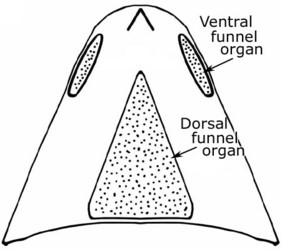
Figure. Funnel organ of C. tongaensis. Left - Dissection paratype 1 showing both ventral organs adjacent to one another at the midline. Right - Diagram showing the arrangement and shape of the organs. Photograph and drawing from Lu and Boucher-Rodoni (2006).
- Lateral funnel adductors present.
- Fins
- Large, ear-shaped (free anterior and posterior lobes); attached obliquely relatively to dorsal mantle midline.
- Anterior tip of fins 26-27% of ML from anterior mantle margin; posterior tip 9-23% of ML from posterior mantle margin.
- Large, ear-shaped (free anterior and posterior lobes); attached obliquely relatively to dorsal mantle midline.
- Pigmentation
- Alcohol preserved specimen brown; dark chocolate brown chromatophores scattered over brown-colored background.
- Dorsal mantle surface lighter than ventral surface.
- Gladius
- Gladius rudimentary: thin, narrow gladius on anterior half of mantle only.
- Gladius rudimentary: thin, narrow gladius on anterior half of mantle only.
- Viscera
- Gills with 25-26 lamellae per demibranch, plus a terminal lamella.
- Median mantle septum present with ventral mantle adductor at anterior end. Mantle adductor passes lateral to rectum just beyond photophore pores.
- Anal flaps large.
- Ink sac large.
- Gills with 25-26 lamellae per demibranch, plus a terminal lamella.
- Measurements and counts
Holotype Paratype 1 Paratype 2 Sex Female Male Female Maturity Mature
Probably mature
Subadult
Dorsal mantle length 33.8
Head only
24.3
Ventral mantle length
29
-
24
Head length
18
17
13
Head width 18
20
14
Nuchal commissure width
14
13
11
Mantle width
23
-
17
Eye diameter 12 11
11
Funnel length
23
19
15
Funnel width
12
9
9
Free funnel length
17
16
12
Fin length
20
-
10
Fin width
12
-
10
Length, Arm I
35 27
15
Length, Arm II
41 30
18
Length, Arm III
41 30
18
Length, Arm IV
25
22
17
Arm formula
2=3.1.4.
2=3.1.4
2.3.4.1
Web sector A
4 3
2.4
Web sector B
2.2
2.3
2.6
Web sector C
3.5
2.3
4.6
Web sector D
11
9
7
Web sector E
4.3
3.2
1.2
Largest sucker diam., arm I
1.6 1.6
0.6
Largest sucker diam., arm II
2.7
4.3
0.8
Largest sucker diam., arm III
3.9
3.1
0.7
Largest sucker diam., arm IV
1.2
0.9
0.5
Tentacle length
-
45
-
Club length
-
13
-
Comments
The above description with the exception of a few photographs is taken from Lu and Boucher-Rodoni (2006).
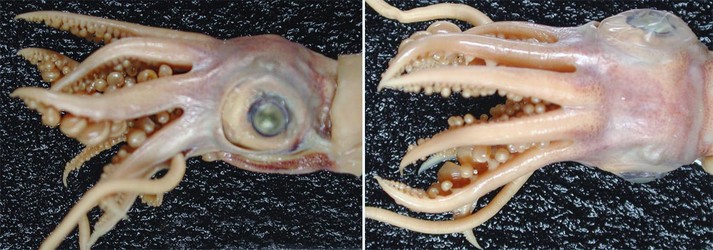
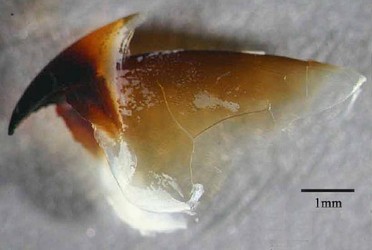
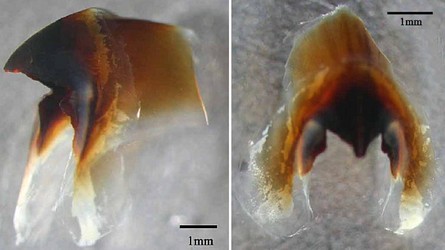
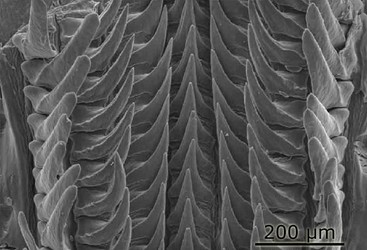



 Go to quick links
Go to quick search
Go to navigation for this section of the ToL site
Go to detailed links for the ToL site
Go to quick links
Go to quick search
Go to navigation for this section of the ToL site
Go to detailed links for the ToL site